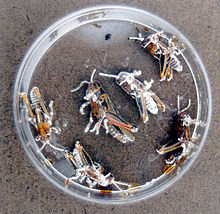| Beauveria bassiana | |
|---|---|

| |
| Grasshoppers killed by B. bassiana | |
| Scientific classification | |
| Domain: | Eukaryota |
| Kingdom: | Fungi |
| Division: | Ascomycota |
| Class: | Sordariomycetes |
| Order: | Hypocreales |
| Family: | Cordycipitaceae |
| Genus: | Beauveria |
| Species: | B. bassiana
|
| Binomial name | |
| Beauveria bassiana (Bals.-Criv.) Vuill. (1912)
| |
| Synonyms | |
| |
Beauveria bassiana is a fungus that grows naturally in soils throughout the world and acts as a parasite on various arthropod species, causing white muscardine disease; it thus belongs to the group of entomopathogenic fungi. It is used as a biological insecticide to control a number of pests, including termites, thrips, whiteflies, aphids and various beetles. Its use in the control of bed bugs[1] and malaria-transmitting mosquitos is under investigation.[2]
- ^ Barbarin, Alexis M.; Jenkins, Nina E.; Rajotte, Edwin G.; Thomas, Matthew B. (15 September 2012). "A preliminary evaluation of the potential of Beauveria bassiana for bed bug control" (PDF). Journal of Invertebrate Pathology. 111 (1): 82–85. doi:10.1016/j.jip.2012.04.009. PMID 22555012. Archived from the original (PDF) on 14 July 2020. Retrieved 21 November 2012.
- ^ Donald G. McNeil Jr., Fungus Fatal to Mosquito May Aid Global War on Malaria, The New York Times, 10 June 2005